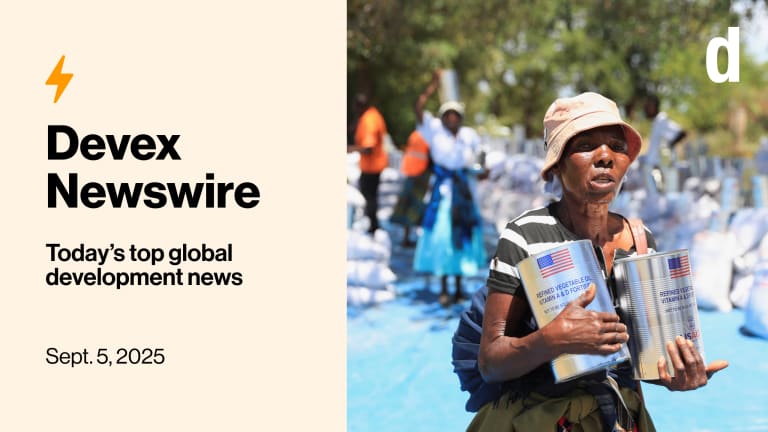
ABIDJAN — As the Democratic Republic of the Congo attempts to contain an Ebola outbreak and stabilize ongoing political tensions in the nation’s capital, 400,000 children under age 5 in the country’s southwest Kasai region suffer from severe acute malnutrition and are at immediate risk of dying from starvation.
Since early 2017, intercommunal fighting has displaced 1.4 million people, who fled from widespread violence and severe human rights violations in the Kasai crisis. Many families hid in forested areas for several months at times, humanitarians tell Devex, often with no access to drinking water or health care and very limited access to food.
In recent months, the violence has subsided and public services have resumed, but aid workers say they are spread too thin to meet the needs of the returnees and displaced populations, along with those needs of host communities to which some internally displaced people have relocated.
“A child that is suffering from severe acute malnutrition and at risk of dying is something that is already happening and children are dying because they are not getting the assistance they need …”
— Yves Willemot, communications director at UNICEF DRC“We have noticed a diminishing in the intensity of the conflict which is causing thousands to return home, and the problem there is, there is little to no capacity to provide assistance to all those people seeking to rebuild their lives,” Abeer Mezher, Kasai area manager for the Norwegian Refugee Council explained.
Mezher said current patterns mimics what she calls “pendulum migration,” where returnees are displaced to search for humanitarian assistance after coming back home to destroyed property and burned fields.
The United Nations Children’s Fund estimates that 770,000 children under age 5 in the region are suffering from malnutrition, with more than half of those facing starvation from severe malnutrition.
“A child that is suffering from severe acute malnutrition and at risk of dying is something that is already happening and children are dying because they are not getting the assistance they need due to inaccessibility or because they are still displaced or because of lack of resources,” UNICEF DRC Communications Director Yves Willemot noted.
However, Willemot also explained that severe acute malnutrition can be reversed within a matter of days without any long-term consequences for the child.
To address the malnutrition, UNICEF is working alongside local health authorities to increase awareness and improve diagnosing. Local health centers were also provided “therapeutic foods,” namely vitamin-enriched pasta, to distribute to the families of children categorized as severely malnourished.
“When we discover that a child is suffering from severe acute malnutrition, we provide the household with this ready-to-use therapeutic food on an ambulatory basis, meaning that they can take it home and come back on a daily basis to be monitored on the evolution of their situation,” Willemot told Devex. Those unable to chew on their own are referred to a particular hospital in each health zone for therapeutic milk doses until complications subside.
NRC has aimed for a multisectoral intervention against malnutrition by targeting more than 35,000 households, or 215,000 people, with food, money, agriculture tools, seeds, and education on good nutritional practices. As an implementing partner with programs funded by UNICEF, the U.N. High Commissioner for Refugees and European Civil Protection and Humanitarian Aid Operations, among others, this “integrated community approach,” Mezher said, allows NRC to understand the people they serve and what kind of programming will best support their survival.
Since last year, UNICEF has also supported some 70,000 of the most acute malnutrition cases and has complimented the World Food Programme’s food distribution activities and the Food and Agriculture Organization in restarting agricultural production through seed disbursements, Willemot explained further.
The U.N. estimates that locals in the Kasai region have lost three harvests, and even for those that returned, the first cultivation is not expected until late summer, leaving many dependent on donor assistance.
For the Kasai region alone, Willemot said UNICEF is seeking $88 million to fully implement its programs, with $45 million directly related to the nutritional component of its humanitarian assistance in the area — of which 25 percent is currently funded.
EU preps for DRC donor conference as crisis worsens
The European Commission, U.N, and Dutch government will co-host a pledging conference in April to address the "huge" humanitarian challenge in DRC. Without urgent help, many leading aid figures are warning of a rapidly deteriorating crisis, Devex reports.
Underfunding in DRC remains an impediment to the humanitarian response. In April, $528 million were pledged at a U.N.-led donor conference for the various humanitarian needs in the country, still less than half of the $1.6 billion requested in the 2018 DRC Humanitarian Response Plan.
“Funding appeals improved towards the end of last year, but funds are now diminishing because donor nations don’t see Kasai as an emergency situation anymore,” Mezher criticized, which for “drastically underfunded” sectors such as protection, education, and coordination she said could trigger a worsening humanitarian situation.








